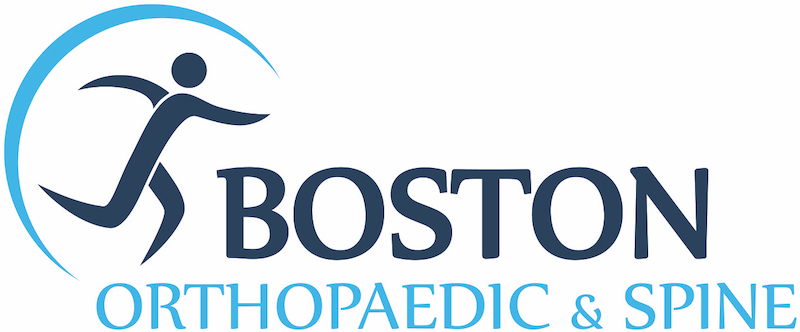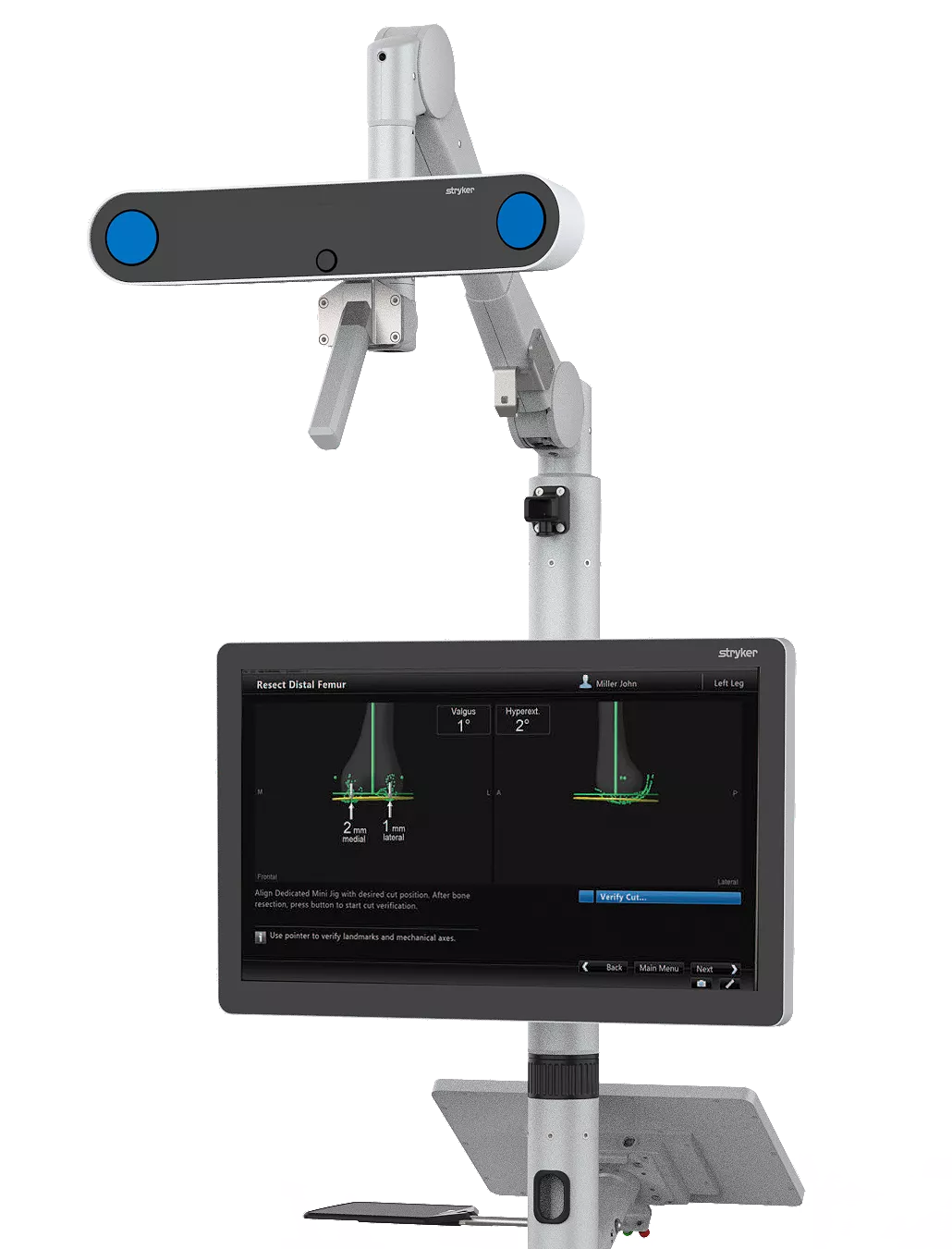Hip Replacement
Advanced hip replacement, revision and resurfacing
What is Hip Replacement?
Hip replacement or resurfacing is sometimes recommended for patients with advanced-stage arthritis that does not respond to non-operative treatments. The damaged bone and cartilage is removed and replaced by components made of ceramic, metal, and plastic. These parts work to restore function, improve mobility, and decrease pain.
Total hip replacement involves completely replacing the hip joint, whereas hip resurfacing only replaces the damaged tissues on the surface.
Advanced Technology at Boston Orthopaedic & Spine
Advanced computer-assisted surgical monitoring with the Stryker Navigation System helps your surgeon precisely align your hip implant with computer imaging. The Stryker Navigation System gives your surgeon 3-D imaging of your leg during surgery, which may result in more exact placement of the implants.
Armed with this information, the surgeon can make adjustments within a fraction of a degree, helping to ensure the best outcome for each patient with pinpoint accuracy.
Offering Advanced Surgical Techniques
Hip Resurfacing
Hip resurfacing is a type of hip replacement that aims to remove less of the patient’s bone than traditional hip replacement surgery. Instead of replacing the entire hip joint, only the damaged surfaces of the ball and socket are replaced. This procedure is most suitable for younger, more active patients.
Anterior Hip Replacement
Anterior hip replacement is a surgical technique in which the hip joint is accessed through the front instead of the back. This allows for less muscle trauma during surgery, resulting in a smoother recovery and less pain post-surgery. The anterior approach also has a very low rate of dislocation post-surgery (0.1% of cases).
Robotic Hip Replacement
Robotic hip replacement is a surgical procedure that uses a robotic system to assist the surgeon in performing a hip replacement. The robot provides exact precision and stability during the procedure, resulting in improved outcomes for patients.
Our Specialist
As with all surgical procedures, it is imperative to choose a surgeon with a proven track record in this specialty, and feeling comfortable with your surgeon will have a positive impact on your overall experience.
Schedule an appointment today with our hip specialist who will help you determine if a hip replacement is right for you.
Daniel C. Mascarenhas, MD
Learn More
Information for Patients
Possible Complications and Risks
The complication rate following total hip replacement is low. Serious complications, such as a hip infection, occur in fewer than 1-2% of patients. At Mount Auburn Hospital and New England Baptist, our rates are <1%. Major medical complications such as heart attack or stroke occur even less frequently. Chronic illnesses may increase the potential for complications. Although uncommon, when these complications occur, they can prolong or limit full recovery.
Factors known to increase surgical risks include diabetes, obesity, peripheral vascular disease, prior joint infections, and major depression or mental health concerns. Please talk with your surgeon if you have concerns about your risk for surgery.
Complications associated with hip replacement procedures include:
Infection
Infection may occur in the wound or deep around the prosthesis. It may happen while in the hospital or after you go home. It may even occur years later. Minor infections in the wound area are generally treated with antibiotics. Major or deep infections may require more surgery and removal of the prosthesis. Any infection in your body can spread to your joint replacement.
Hip Dislocation
The rate of hip dislocation after a posterior approach is 3%. This rate is much lower with the anterior approach, approaching 0.1%.
Blood Clots
Blood clots in the leg veins are one of the most common complications of knee replacement surgery. These clots can be life-threatening if they break free and travel to your lungs. The best way to minimize your risk is to move and walk. While in the hospital, you will receive sequential compression devices (SCDs) and you may even go home with a portable pair. You will also receive medications to thin the blood. We typically use either Aspirin, Eliquis, Arixtra, Lovenox, or Coumadin. If you have any personal or family history of bleeding or clotting disorders, please alert your surgeon.
Implant Problems
Although implant designs and materials, as well as surgical techniques, continue to advance, implant surfaces wear with time and the components may loosen. The rates of wear have improved considerably with newer implant designs.
Continued Pain
A small number of patients continue to have pain after a hip replacement. When present, it is often associated with spine pathology or inflammation of the tissues around the hip.
Neurovascular Injury
While rare, injury to the nerves or blood vessels around the hip can occur during surgery.
Unique Complications for Anterior Hip Replacement
Complications uniquely associated with anterior hip replacement include numbness along the thigh associated with injury to the lateral femoral cutaneous nerve, increased risk of fracture of the femur during surgery as exposure is more challenging, more wound healing issues often caused by irritation of the skin at the top of the incision.
How to Prepare for Hip Replacement Surgery
In addition to recommendations and pre-operative care by your physician, there are several things any patient can do to help ready their mind, body and lifestyle for their knee replacement procedure.
Exercise
It’s important to be in the best possible overall health to help promote the ideal hip replacement experience and outcome. Increasing upper body strength is important because of the need to use a walker or crutches after hip or knee replacement. Strengthening the lower body is also key because increasing leg strength before surgery can help reduce recovery time.
Dental Health
Although infections after joint replacement are not common, an infection can occur if bacteria enter the bloodstream. Therefore, dental procedures such as extractions and periodontal work should be completed before joint replacement surgery. We recommend waiting for 3 months after surgery before any post-operative dental cleaning or procedures.
Limit the Use of Narcotics
There is an association between preoperative opioids and more postoperative pain. Whenever possible, this can be improved by limiting their use leading up to surgery
Stop Certain Medications
You will learn which specific medications need to be stopped prior to your surgery when you come to Pre-Admission Testing for your Pre-Operative appointment. If you are taking blood thinners, they will need to be stopped prior to surgery.
Stop Smoking
It’s a good idea to stop smoking before any major surgery in order to help reduce the risk of post-operative lung problems and improve healing.
Lose Weight
For patients who are obese, losing weight will help reduce stress on the new joint. There is a markedly increased risk of complications in patients with a BMI over 35.
Plan for At-Home Care Post-Surgery
Every patient who undergoes total joint replacement will need help at home for the first few weeks following their knee replacement surgery, including assistance with preparing meals and transportation. If possible, ensure your home is accessible for the use of a walker or crutches.
What to Expect for Surgery
Pre-admission Testing
Within 1 month of your surgery, you will be asked to undergo several laboratory tests, an electrocardiogram, and a chest x-ray. This is called pre-admission testing. This will help us to tell whether there are any conditions which might increase the risk of surgery. A physical examination, performed by your primary care physician and cardiologist/pulmonologist (if necessary), is also a part of pre-admission testing.
Joint Class
All patients should attend a joint class prior to their surgery. This will be arranged by your surgical coordinator and plays a very important role in your surgical preparation. Patients who attend this class have demonstrated a more predictable and successful recovery.
Just Before Surgery
You will be asked to arrive 1.5-2 hours prior to your scheduled surgery time.
You will not be allowed to drink or eat anything after midnight and on the day of your surgery. In some cases, you may be allowed to take a medication you normally take in the morning with a minimal amount of water. If instructed to do so, you will need to let the admitting nurse know.
Anesthesia
You will be seen by the anesthesiologist on the day of surgery. The anesthesiologist can answer specific questions you might have. Most of our surgeries are performed under spinal anesthesia, though we will also use regional and general anesthesia when a spinal does not seem to be the best option.
You may receive some medications in the holding area prior to your surgery. These may include specific pain medications and antibiotics for your surgery.
The Surgery
Joint replacement involves the removal of all of the damaged bone and cartilage. The next step is to prepare the bone for the prosthesis. This involves using specialized tools to shape the bone so that the prosthesis will fit properly. The artificial joint is then placed into the bone with or without bone cement. The surgery itself takes between 1.5-3 hours, depending on the complexity of your case.
The surgical approach is a topic of frequent discussion. When bone quality allows, we generally perform anterior hip replacement using muscle-sparing techniques. This allows for a faster early recovery and does not require strict mobility precautions. Alternative approaches, such as direct lateral or posterior, are utilized on a case specific basis.
Recovery Room
When your surgery is completed, you will go to the recovery room where you will be closely monitored until the effects of the anesthesia and intra-operative medicines are decreased and you are relatively awake and comfortable.
Orthopedic Unit
When you have completed your stay in the recovery room, you will be transferred to your hospital room in the orthopedic nursing unit. As long as you feel well, you will be out of bed on your day of surgery, taking your first steps. The therapists will instruct you how to use crutches or a walker, and some of the precautions that are necessary in the immediate post-operative period. Our therapists will help you navigate these first challenging days.
Discharge
Most patients will be able to go home 1-2 days after surgery. Some will stay for a 3rd day and others may go to a short-term rehab facility to help improve strength and gait. In order to be discharged, you need to be safe moving out of your bed/chair, have pain controlled by medications you can take at home, and be able to tolerate food.
Recovery and Post-Operative Care
There are several components to the rehabilitation and recovery process. Each one is integral to the entire course of healing. These components include:
Physical Therapy
During the first several days/weeks of physical therapy, some degree of discomfort and stiffness is expected. As the therapy continues, your body will adjust to the new prosthetic, allowing it to operate as part of your leg. Even after physical therapy is concluded, the knee needs to continue being active. Walking or other mild activities are perfect to increase mobility over time. It may take 12-18 months for your muscles to fully strengthen.
Incision Care
A sterile dressing will be applied in the operating room. If dry, this dressing will often remain for 1 week. Afterwards, it can be removed and covered with a dry dressing. You must keep the incision dry for the first 10-14 days. Do not soak the knee for 4 weeks after surgery.
DVT Prophylaxis
Lower extremity surgery poses an increased risk for blood clots. In mobile patients, Aspirin 2x/day for 6 weeks will thin the blood enough to minimize this risk. In patients with a history of clotting, decreased mobility, or GI issues, alternatives such as Eliquis, Lovenox, Arixtra, or Coumadin will be prescribed.
Follow-up
For the first year following surgery, scheduled follow-up appointments will ensure that recovery is going as planned. We would like to see you at 2 weeks, 6 weeks, 3 months, and one year after your surgery. After that, annual visits may be expected to keep your hip in peak condition.
Take the First Step
Get an accurate diagnosis and treatment plan from our expert physician team.



